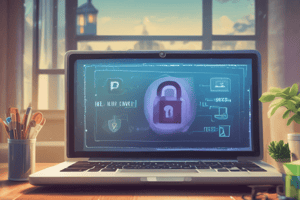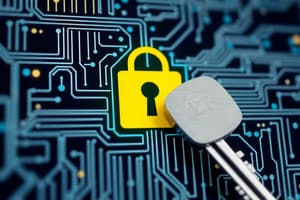Podcast
Questions and Answers
Which type of information is used for login in User Account Management?
Which type of information is used for login in User Account Management?
- Email address (correct)
- Social security number
- Username
- Phone number
What is required to access multiple clients in User Account Management?
What is required to access multiple clients in User Account Management?
- Multiple passwords
- Multiple phone numbers
- Multiple usernames
- Multiple email addresses (correct)
How many email addresses are required for accessing multiple clients in User Account Management?
How many email addresses are required for accessing multiple clients in User Account Management?
- Four email addresses
- Three email addresses
- One email address
- Two email addresses (correct)
True or false: User Account Management allows for multiple users per client.
True or false: User Account Management allows for multiple users per client.
True or false: Email addresses are used for login in User Account Management.
True or false: Email addresses are used for login in User Account Management.
True or false: Accessing multiple clients in User Account Management requires multiple email addresses.
True or false: Accessing multiple clients in User Account Management requires multiple email addresses.
Match the following User Account Management concepts with their descriptions:
Match the following User Account Management concepts with their descriptions:
Match the following User Account Management actions with their requirements:
Match the following User Account Management actions with their requirements:
Match the following User Account Management scenarios with the correct number of email addresses required:
Match the following User Account Management scenarios with the correct number of email addresses required:
Which of the following is true about user account management?
Which of the following is true about user account management?
What is required to access multiple clients?
What is required to access multiple clients?
What is the purpose of using email addresses for login?
What is the purpose of using email addresses for login?
Match the following User Account Management tasks with their descriptions:
Match the following User Account Management tasks with their descriptions:
Match the following User Account Management concepts with their definitions:
Match the following User Account Management concepts with their definitions:
Match the following User Account Management actions with their outcomes:
Match the following User Account Management actions with their outcomes:
Match the following User Account Management tips with their descriptions:
Match the following User Account Management tips with their descriptions:
Match the following statements with their accuracy regarding User Account Management:
Match the following statements with their accuracy regarding User Account Management:
Match the following terms with their relevance to User Account Management:
Match the following terms with their relevance to User Account Management:
Match the following User Account Management processes with their descriptions:
Match the following User Account Management processes with their descriptions:
Match the following User Account Management tasks with their level of complexity:
Match the following User Account Management tasks with their level of complexity:
Match the following User Account Management actions with their required resources:
Match the following User Account Management actions with their required resources:
Match the following user account management practices with their descriptions:
Match the following user account management practices with their descriptions:
Match the following user account management terms with their definitions:
Match the following user account management terms with their definitions:
Match the following user account management actions with their requirements:
Match the following user account management actions with their requirements:
Match the following user account management recommendations with their descriptions:
Match the following user account management recommendations with their descriptions:
Match the following user account management best practices with their definitions:
Match the following user account management best practices with their definitions:
Match the following user account management strategies with their explanations:
Match the following user account management strategies with their explanations:
Match the following user account management concepts with their descriptions:
Match the following user account management concepts with their descriptions:
Match the following user account management steps with their requirements:
Match the following user account management steps with their requirements:
Match the following user account management measures with their explanations:
Match the following user account management measures with their explanations:
Which of the following is a key task involved in user account management?
Which of the following is a key task involved in user account management?
What is one benefit of using specialized user account management software?
What is one benefit of using specialized user account management software?
What is the purpose of user account management in IT security?
What is the purpose of user account management in IT security?
What is one recommendation for effective user account management?
What is one recommendation for effective user account management?
What is one consequence of not properly managing user accounts?
What is one consequence of not properly managing user accounts?
What is one potential challenge of manual user account management?
What is one potential challenge of manual user account management?
What is one task involved in modifying user accounts?
What is one task involved in modifying user accounts?
What is one aspect of user account management that helps meet regulatory requirements?
What is one aspect of user account management that helps meet regulatory requirements?
What is one action involved in managing user access?
What is one action involved in managing user access?
Which of the following is an example of two-factor authentication?
Which of the following is an example of two-factor authentication?
What is the purpose of two-factor authentication?
What is the purpose of two-factor authentication?
What should be monitored for suspicious activity?
What should be monitored for suspicious activity?
When should user accounts be deleted?
When should user accounts be deleted?
What is the benefit of using a centralized user account management system?
What is the benefit of using a centralized user account management system?
Which of the following is NOT an example of two-factor authentication?
Which of the following is NOT an example of two-factor authentication?
What is the purpose of monitoring user activity?
What is the purpose of monitoring user activity?
When should user permissions be updated?
When should user permissions be updated?
What is the benefit of using a centralized user account management system?
What is the benefit of using a centralized user account management system?
User account management involves creating, modifying, and deleting user accounts.
User account management involves creating, modifying, and deleting user accounts.
User account management is not important for IT security.
User account management is not important for IT security.
Manual user account management is less prone to errors than using specialized software tools.
Manual user account management is less prone to errors than using specialized software tools.
User account management involves granting or denying user access to specific systems and resources.
User account management involves granting or denying user access to specific systems and resources.
Managing user access involves monitoring user activity and taking corrective action if necessary.
Managing user access involves monitoring user activity and taking corrective action if necessary.
User account management is not important for regulatory compliance.
User account management is not important for regulatory compliance.
Using a strong password policy is not necessary for effective user account management.
Using a strong password policy is not necessary for effective user account management.
User account management can be automated using specialized software tools.
User account management can be automated using specialized software tools.
Monitoring user activity is not necessary for effective user account management.
Monitoring user activity is not necessary for effective user account management.
True or false: Two-factor authentication adds an extra layer of security to user accounts by requiring users to provide two factors of authentication, such as a password and a one-time code generated by a mobile app.
True or false: Two-factor authentication adds an extra layer of security to user accounts by requiring users to provide two factors of authentication, such as a password and a one-time code generated by a mobile app.
True or false: Monitoring user activity helps to identify suspicious activity, such as failed login attempts or access to sensitive data.
True or false: Monitoring user activity helps to identify suspicious activity, such as failed login attempts or access to sensitive data.
True or false: Deleting user accounts when employees leave the company is an important step in keeping user accounts up to date.
True or false: Deleting user accounts when employees leave the company is an important step in keeping user accounts up to date.
True or false: A centralized user account management system can simplify and automate the process of managing user accounts.
True or false: A centralized user account management system can simplify and automate the process of managing user accounts.
True or false: Two-factor authentication requires users to provide three factors of authentication.
True or false: Two-factor authentication requires users to provide three factors of authentication.
True or false: Monitoring user activity is not necessary for maintaining the security of user accounts.
True or false: Monitoring user activity is not necessary for maintaining the security of user accounts.
True or false: Updating user permissions when employees change roles is not necessary for keeping user accounts up to date.
True or false: Updating user permissions when employees change roles is not necessary for keeping user accounts up to date.
True or false: Using a centralized user account management system can complicate the process of managing user accounts.
True or false: Using a centralized user account management system can complicate the process of managing user accounts.
True or false: Two-factor authentication can be bypassed by hackers.
True or false: Two-factor authentication can be bypassed by hackers.
![[02/Conchos/01]](https://images.unsplash.com/photo-1528040687826-bb1548224f87?ixid=M3w0MjA4MDF8MHwxfHNlYXJjaHwyN3x8Y3liZXJzZWN1cml0eSUyMGF0dGFjayUyMHBhdHRlcm5zJTIwbWFpbnRhaW5pbmclMjBhY2Nlc3MlMjByb290a2l0c3xlbnwxfDB8fHwxNzA0NDAyMDMxfDA&ixlib=rb-4.0.3&w=800&fit=crop&h=300&q=75&fm=webp)




